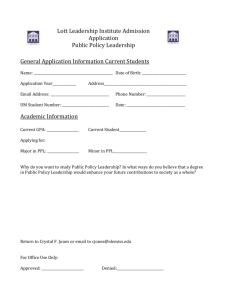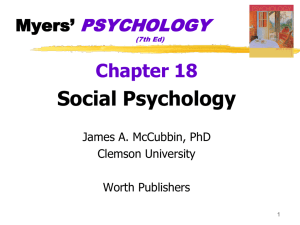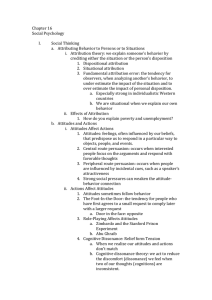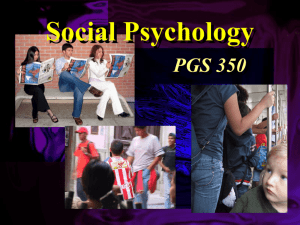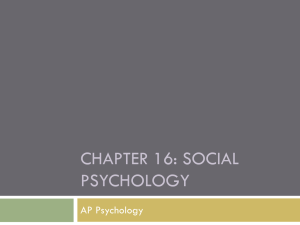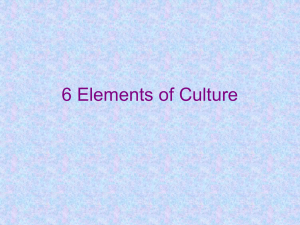Social Psychology
advertisement
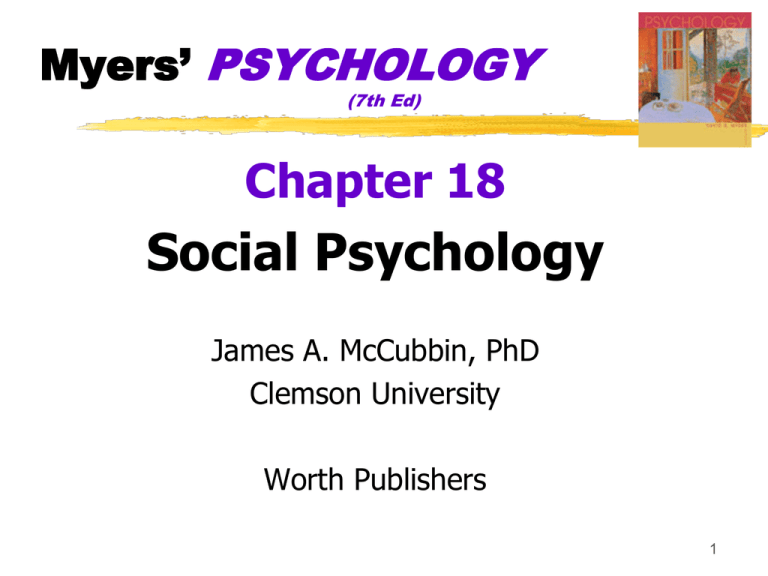
Myers’ PSYCHOLOGY (7th Ed) Chapter 18 Social Psychology James A. McCubbin, PhD Clemson University Worth Publishers 1 Ch. 18: Social Psychology Social Thinking Social Psychology: scientific study of how we think about, influence, & relate to one another Attribution Theory: How we “attribute” something to someone…to us…or to others… tendency to give a causal explanation for someone’s behavior, often by crediting either the situation or the person’s disposition… situational vs. dispositional factors Fundamental Attribution Error tendency for observers, when analyzing others’ behaviors, to underestimate how much of the situation is to blame…& to overestimate the impact of personal disposition Attitude belief & feeling that influences us to respond in a particular way to objects, people & events 2 Fundamental Attribution Error 3 Social Thinking How we explain someone else’s behavior affects how we react to it … “It’s because…..” Situational attribution “Maybe that driver is ill.” Tolerant reaction (proceed cautiously, allow driver a wide berth) Dispositional attribution “Crazy driver!” Unfavorable reaction (speed up and race past 4the other driver, give a dirty look) Negative behavior Social Thinking Our behavior is affected by our inner attitudes as well as by external social influences: Internal attitudes + External attitudes = Behavior effects Internal attitudes External social influences Behavior 5 Social Thinking Attitudes follow behavior… which follow attitudes… which follow behavior...etc.. Cooperative actions feed mutual liking… ...encouraging us to like another… So...Smile at someone! 6 Social Thinking PERSUASION: How we influence & are influenced by others CENTRAL ROUTE TO PERSUASION vs. PERIPHERAL ROUTE TO PERSUATION: (NOT in your book!) Which tends to be a stronger, longer lasting change? Foot-in-the-Door Phenomenon: If you ask ppl 1st agreed for a small request…then later make a larger request = more compliance (going along..) on the later requests ----------------------------------------------------------------------------------------- SOCIAL ROLES (aka “roles”): set of expectations about a social position…can affect how we behave & expect others to behave How ppl in a particular position should behave Zimbardo’s Stanford Prison Experiment: Looked at social roles in his “prisoner/guard” study using college students (p. b-700) D-M video 7 Foot-in-the –Door Phenomenon is a form of persuasion that has been used in sales, in politics, in cult-behavior: Used by communists, liberals, conservatives, humanitarian groups, Muslims, Christians, atheists, etc.… It is very effective! Good EX: N. Koreans on US POW’s in ‘50’s 8 *Central Route to Persuasion vs. Peripheral Route to persuasion: Which tends to be a stronger, longer lasting change? The Central Route to Persuasion involves being persuaded by the arguments or the content of the message. EX: You hear a political debate & decide to vote for a candidate because you found the candidates views & arguments very convincing. Tends to = a more lasting belief change The Peripheral Route to Persuasion involves being persuaded in a way not based on the arguments or the message content, but other factors EX: after reading a political debate you may decide to vote for a candidate because you like the sound of the person's voice, or the person went to the same university as you did…or someone you admire (EX’s: Mel Gibson, Bruce Springsteen) supports & speaks for the candidate. Can also involve using superficial cues such as the attractiveness of the speaker, his/her accumulated wealth, etc. This is more susceptible to an attitude change later 9 10 Zimbardo’s Stanford Prison Experiment & the Effects of Social Roles on Our Behaviors 11 Stanford Prison Study & Abu Ghraib Prison in Iraq: Which is real & which is “set up?” Would good Americans do this? 12 Cognitive Dissonance Theory: Leon Festinger We try to reduce the discomfort (dissonance) we feel when two of our thoughts (cognitions) are inconsistent EX: When we become aware that our attitudes & our actions clash, we reduce resulting dissonance 13 Dilbert Cartoon: “Dogbert” strikes again...this time using Cognitive Dissonance! changing our attitudes…Clemson/Carolina??? 14 Cognitive Dissonance: Another Ex: 15 Social Influence: Effects of others on us… Be sure you can differentiate! AND ID which famous psych study (or concept) goes with which idea.. Obedience: following orders from someone in a position of authority over us (St. M.?) Compliance: going along w/ a request from someone who is NOT in a position of authority…you just choose to do so (Ft N dr??) Conformity: adjusting one’s behavior or thinking to coincide with a group standard…there’s no request…you just choose to (Sol.As.?) Normative Social Influence: influence resulting from a person’s desire to gain approval or avoid disapproval Chameleon Effect: unconsciously mimicking others expressions, emotions, moods (someone smiles, you smile) relates to mood linkage & mood contagion 16 Social Influence The chameleon effect: Human see, human do… If 1 shakes foot, etc., others around will copy (Yawning??) Moods & chameleon effect: we also “catch” others’ moods (mood linkage & mood contagion) Number of times 0.8 0.7 0.6 0.5 0.4 0.3 Participant rubs face Confederate rubs face Participant shakes foot Confederate shakes foot17 Mood linkage/mood contagion & Mob violence? 18 Social Influence: Asch’s experiment on conformity… Informational Social Influence: Conforming: Influence resulting from one’s willingness to accept others’ opinions about reality Happens especially as a larger & larger group agrees, OR if those agreeing have higher status or “coolness” levels Participant shows confusion RE: his answer vs. others answers… 19 Stanley Milgram’s Obedience Study: Yale University 20 Social Influence Milgram’s follow-up obedience experiment 21 Social Influence Some individuals resist social coercion (force). Student stands up to tank in Tiananmen Square in Beijing, China (translates literally to Gate of Heavenly Peace) 22 Individualistic cultures vs. Collectivist Cultures: Discovering Psy Video: Prg. 26: Cultural Psych 23 Social Facilitation vs. Social Loafing: Social Facilitation: improved performance of tasks in the presence of others… -We do better around others…if ppl we know are watching occurs with simple or well-learned tasks but not with tasks that are difficult or not yet mastered Social Loafing: tendency for people in a group to exert less effort when pooling their efforts toward attaining a common goal than when individually accountable… do worse around others 24 Social Facilitation: Sometimes when others are working hard, we don’t wanna’ be seen as the “slacker” so we work harder, too! 25 Social Loafing: aka “Water cooler effect:” Others can influence us to goof off in order to be “one o’ the gang...” And if the others are doing it, why should I sweat it?? Classic example: Tug-o-War : Is it really up to ME? 26 Social Facilitation ALSO relates to: What we do well, we do better in front of an audience …especially a friendly audience: The Home court advantage! 27 Deindividuation Loss of self-awareness & self-restraint in group situations that foster arousal & anonymity (mob behavior..Halloween?) Can lose individual idea of responsibility…& feel no one will know it was you…”It was ALL of us…” “But EVERYbody was doing it!” “Nobody knows me here... “ Group Polarization: “Twelve Angry Men” enhancement of a group’s prevailing attitudes through discussion within the group Those w/ similar ideas in beginning become even STRONGER and more assured of their ideas & beliefs EX: liberals around liberals become more liberal…conservatives around conservatives become more conservative…. Tend to pull toward the group attitudes What can pull them over? If 1 who can see another possibility will communicate w/ others & hold fast to convictions, others may “change poles” 28 Groupthink: mode of thinking that occurs when the desire for harmony in a decision-making group overrides realistic appraisal of alternatives Leaders & “Yes-men”: big problem w/ powerful people who only want those who agree w/ them 29 30 Social Influence p. 711) If we can just DISCUSS an issue, maybe we can get good ideas?? Group Polarization: If a group is like-minded, discussion makes those ideas stronger… ”See we’re right!!” Low-prejudice groups tend to lessen prejudice…but hi-prejudice ones tend to increase prejudice… 31 Social Relations Discrimination: actual acts against people of a particular group b/c they are a part of that group Prejudice an unjustifiable (& usually negative) attitude toward a group & its members involves stereotyped beliefs, negative feelings, & a predisposition to discriminatory action Stereotype a generalized (sometimes accurate, but often overgeneralized) belief about a group of people The other race effect: “They all look alike” Tendency to see very little differences w/in ppl from another race In-group “Us”- people with whom one shares a common identity Out-group “Them”- those perceived as different or apart from one’s ingroup 32 Stereotypes USA?? IN vs. OUT Group 33 Power of the individual vs. minority influence: When the few control ideas/actions of the many... A few committed ppl can have tremendous influence on others...and can be for good—or not so good.. (See Margaret Mead quote...) Gandhi, Jesus, Dr. ML King, Hitler, K. Marx—and then over-throw of czar in 1917...THEN down-fall of of communist USSR in 1989. ---Can also be Jim Jones...David Koresh...& other cult leaders (BTW: “cult” means to care strongly about something) Committed ppl can convince others—and bring great changes Group think: how we pull to majority— Minority influence: How some begin in small Charismatic? Can equal very strong leadership ability 34 Prejudice: KNOW Browneyes/Blueeyes study Jane Elliot below, Left 35 Social Relations Does perception change with race? If you think not, read Black like Me… 36 Social Relations Americans today express much less racial & gender prejudice …voting for women OR keeping minorities OUT… But subtle prejudice continues… ?: Do you think it is better to express it if you feel it…or to know it should not be stated? 37 Social Relations In-group Bias tendency people have to favor one’s own group and to see them in a more positive light “halo-effect” can relate to this: those we see positively we notice their good and excuse their bad times (“situational/dispositional”?) Scapegoat Theory theory that prejudice provides an outlet for anger by providing someone to blame EX: You don’t get into a college you want— probably b/c of less deserving ppl being accepted! And it is NOT fair! 38 Just-World Phenomenon Tendency of people to believe the world is just & that ppl get what they deserve... & deserve what they get “If ppl are poor, it is their own fault b/c they COULD fix it…there are no excuses!” BUT...if bad happens to me/mine, it is out of my control! (situational vs. dispositional again??) When it happens to us or ppl we know/like, our excuses for them are part of the “in-group bias” This can involve many aspects… If someone is successful, it is due to his/her being a deserving person Think about Donald Trump…He deserves the success he has, right? 39 ‘Course it didn’t hurt that he was a kid of a wealthy NYC real estate developer who supported his early business efforts and left him a bunch of $$ Do you think he had an early belief in his ability to succeed? Do you think this belief was supported and encouraged? Would these ppl have the same chance for success in the USA? A kid raised in a small mountain town with poor schools and an abusive parent? A kid in a high crime area of a large city w/ a single parent who is hooked on drugs? Do you believe these kids ever think they have a chance at a “regular, successful” life? How might that be true? 40 Just-world-phenomenon is not just about the possibility of success— It also addresses the idea that if bad things happen to you, you did something to bring it on yourself (EX: The Biblical Job—neighbors said he must have made God angry) If a young woman is wearing revealing clothing and is flirtatious, is it her own fault if someone rapes her? If someone is laid off of their job and loses their house and ends up homeless, is it his/her own fault? (Ever hear that most ppl are about “1 paycheck away from homeless?”) 41 Social Relations IF you get on a plane and you see 2 men who look “Muslim, ” would you get nervous? Vivid cases (9/11 terrorists) feed stereotypes 42 Violence and Aggression: Environmental effects on aggression in society: 43 Social Relations and sexual violence: pp.723-725 Men who view porn are less likely to see a rape victim AS a victim But does porn cause rape to increase? Most studies do not directly support that idea 44 Aggression: physical or verbal behavior that’s intended to hurt or to destroy Video games and violence (pp. 725-6) Parallels betw. smoking/cancer & media violence/aggression (top-726) Evidence has been increasing media violence and violent behaviors in children and adolescents Paul Boxer, ass’t prof. of psy., Rutgers University , Newark, involved since 2004 in research funded by the CDC into media violence & its relation to serious youth violence & criminal behavior: “Even in conjunction with other factors, our research shows that media violence does enhance violent behavior,” Boxer states. “On average, adolescents who were not exposed to violent media are not as prone to violent behavior.” http://psychcentral.com/news/2008/11/20/media-violence-linked-toaggression/3379.html 45 Frustration-Aggression Principle: idea that frustration (the blocking of an attempt to achieve some goal) creates anger, which can generate aggression --NOT supported strongly by evidence: causes SOME...but NOT all 46 Doing good ...for goodness sake: Altruism: unselfish regard for the welfare of others doing things for others… even if it puts us at risk… EX’s: ?? MIRROR neurons affect this…If we see others helping others, we are more likely to jump in and help also Kitty Genovese: What happened? Bystander Effect (p. 735) 1964: Kitty Genovese situation led psy to study this phenomenon tendency for any given bystander to be less likely to give aid if other bystanders are present (Note: has been questions as to accuracy of this incident in recent years, but it did get the study started, & the effect HAS been validated in other instances’events) 47 Kitty Genovese & the places she was attacked…repeatedly. 48 Social Relations Effects of people on other people: By-Stander Effect: People were horrified & tried to blame it on “the city”…but it can be seen anywhere So what should you do to keep this from happening? 49 Diffusion of responsibility: Fact that when others are present, we feel less responsibility for others & for our own behavior The decision-making process for bystander intervention… How to avoid the bystander effect: BE WILLING TO TAKE RESPONSIBILITY… 50 Important notes on Aggression Studies: NO 1 thing! Genetics/biology: Aggression “markers” (like genetic traits) have been found on Y the chromosome: testosterone Affects temperament…autonomic (NS??) reactions… Electrode in amydale of a mild-mannered person increased instances Environment: Family? Friends? Temperature? Exposure to guns (Studies: females handling guns--increased testosterone) Lack of father-care: Caring, involved father cuts chances (single mom stress?) Aversive events: Frustration (frustration/aggression principle?) Exposure to war? Sexual violence: Pornography? Group factors? Catharsis Hypothesis? Does watching aggressive acts or playing aggressive games help “get our aggression out?” No…is actually the opposite! Tends to INCREASE Media: Mirror neurons? What type (s) of learning could be involved? Bobo… Watching violent TV/movies can increase—but not as much as PLAYING violent video games Ostracism & us/them: Ppl who are excluded can react w/ violence Group effects? Deindividuation & diffusion of responsibility: 51 Social Relations: Social Conflict: perceived incompatibility of actions, goals, or ideas p. 727 Social Trap trap & game matrix: Person 1 Person 2 Choose B Choose A Choose A Choose B Optimal outcome a situation in which the conflicting parties, by each rationally pursuing their self-interest, become caught in mutually destructive behavior ALL can lose! Probable outcome In Social traps... by pursuing our own self-interest & not trusting others, we can52 ALL end up losers Social Trap Win-Win: Everyone wins! Win-Lose: One winner, other loses Lose-Lose: Both end up losing If you try to get yourself more, you may end up with lose-lose 53 Extra Credit Opportunity!! I will give you an index card Do not speak to anyone else or let them see what you are writing. Write your name onto it. You will write one of the following things on your card— IF the whole class writes "10" everyone gets 10 extra credit points If one-to-three people write "15" ONLY THOSE PPL. GET extra credit - the rest of class gets NONE If FOUR or more people write "15" and get selfish: NO ONE IN THE CLASS GETS POINTS 54 *IF the whole class writes "10" everyone gets 10 extra credit points-WIN WIN FOR ALL! *If one-to-three people write "15" ONLY THOSE PPL. GET extra credit - the rest of class gets NONE! These students also have incentive of 15 points, not just 10! this is a WIN for the "15ers" and LOSE for those who wrote 10 *If FOUR or more people write "15" and get selfish: NO ONE IN THE CLASS GETS POINTS (Lose-lose situation) 55 PEACE Psychology: Resolving Conflicts Enemy perceptions: **US vs. THEM... Great Satan? The evil empire? Biased perceptions: On p. 728: How do the following terms relate to this? Mirror-image perceptions (Great Satan! The evil empire!) Self-serving bias Fundamental attribution error Stereotypes Polarizing Groupthink Self-fulfulling prophecy 56 National & international Cooperation: Making a better world? Peacemaking Psychology: How can ppl make peace? Cooperation, communication, & conciliation Can sometimes change antagonism that comes from prejudice, aggression, & conflicts into attitudes that promote peace… Cooperation: Work for good of both on something—economics? Communication: Talks: at least listen...does not require agreement Conciliation: Each gives a bit to get closer to shared goal NOTE: “Compromise” is NOT a 4-letter word!!57 Reciprocity Norm: If you give me a present, I feel I need to give you a present, too… Social Exchange Theory: Win-win Lose-win Lose-lose Says our social behavior is an exchange process, the aim of which is to maximize benefits & minimize costs Win-win: We both get something & can feel valued! EX:? Lose-win: One gets something…other loses & feels resentment EX: ? Lose-lose: things end up so bad that both end up losing significant things… EX:? WHICH seems best in what situations? 58 Super-ordinate Goals Shared goals that override differences (are more important than) among people & require their cooperation “The need to solve this problem is bigger than both of us” EX: nuclear weapons? 59 G.R.I.T.: Graduated (little by little..) …& Reciprocated (I do 1 thing, U do 1 thing) Initiatives in … Tension-reduction Among nations: I give a bit, you give a bit… a strategy designed to decrease international tensions & make peace one side announces recognition of mutual interests & initiates a small conciliatory act… I’ll do a bit here… Opens door for reciprocation by other party… Me, too…& then I’ll even give… (Related to “reciprocity norm..” If you give me a present for Christmas, I HAVE to give you one 60 too!! Gee…I haven’t wrapped your yet…!) LOVE & social relations: Forming Relationships: How we decide we like or do not ppl Mere Exposure Effect: Repeated exposure to novel (new) stimuli increases the liking of them… WE PREFER WHAT WE ARE USED TO So…The more we are around others, more we are used to them & like them Proximity: Relates to mere exposure effect: Those who live near us, who are in classes with us, who go to activities with us (teams, dance, church, etc.), we are more likely to be attracted to Commonalities: NOT true that opposites attract—we are MOST likely to choose ppl more like us in culture, socio-economic status, attractiveness (avg. & avg., handsome & pretty, etc.), educational values, moral values, etc. 61 WHAT is …& is not … “True Love?” Passionate Love an aroused state of intense positive absorption in another usually present at the beginning of a love relationship Companionate Love deep affectionate attachment we feel for those with whom our lives are intertwined long-term This is more of a “true love”….we still love them though we know all of their quirks, faults, annoying behaviors, etc. Line between love/hate sometimes blurs when we are very angry…but we work things out 62 Social Relations: What increases chances of strong relationships? Equity: a condition in which people receive from a relationship in proportion to what they give to it --each person works just as hard to make things good for the other --each values the other and does not try to belittle the other or feel superior to them (“I got the best deal” …??) Self-Disclosure: revealing intimate aspects of oneself to others…..being willing to share things about ourselves R-E-S-P-E-C-T each other…& TRUST 63 Social Relations: Attractiveness Conceptions of attractiveness vary by culture What is “average” for a culture tends to be the most “attractive” This is thought to be “adaptive” (evolutionary)…Why? --b/c familiar = usually safe Men: prefer young-looking! Women: Prefer status & wealth! 64 Anyone starting to feel like this in AP Psy?? 65
